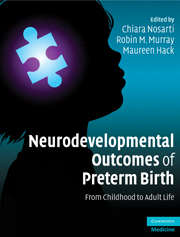Book contents
- Frontmatter
- Contents
- List of contributors
- Preface
- Section 1 Introduction
- Section 2 Neuroimaging
- 4 Imaging the preterm brain
- 5 Structural magnetic resonance imaging
- 6 Magnetic resonance imaging findings from adolescence to adulthood
- 7 Functional neuroimaging following very preterm birth
- 8 Diffusion tensor imaging findings in preterm and low birth weight populations
- Section 3 Behavioral outcome
- Section 4 Neuropsychological outcome
- Section 5 Applied research
- Section 6 Conclusions
- Index
4 - Imaging the preterm brain
from Section 2 - Neuroimaging
Published online by Cambridge University Press: 06 July 2010
- Frontmatter
- Contents
- List of contributors
- Preface
- Section 1 Introduction
- Section 2 Neuroimaging
- 4 Imaging the preterm brain
- 5 Structural magnetic resonance imaging
- 6 Magnetic resonance imaging findings from adolescence to adulthood
- 7 Functional neuroimaging following very preterm birth
- 8 Diffusion tensor imaging findings in preterm and low birth weight populations
- Section 3 Behavioral outcome
- Section 4 Neuropsychological outcome
- Section 5 Applied research
- Section 6 Conclusions
- Index
Summary
Introduction
The three major neuroimaging modalities used in the evaluation of the premature infant brain are cranial ultrasound (CUS), computed tomography (CT), and magnetic resonance imaging (MRI) – each of which has relative strengths and weaknesses. In this chapter, we will compare and contrast these methods with specific regard to their clinical utility in the evaluation of brain injury and altered brain development in the premature infant. A major focus of this chapter will be on MRI, since there have been many recent advances in the application of this methodology in the premature infant.
Due to the high incidence of neurodevelopmental disability in the premature infant, this patient population has a clear need for accurate and reliable neuroimaging. Imaging of the brain of the premature infant has at least two major aims. Firstly, to accurately define the nature of cerebral injury in this population for research purposes; and secondly, to determine the imaging features that most accurately predict adverse neurodevelopmental outcome. In addition to defining direct cerebral injury, recently developed neuroimaging techniques are now providing insight into alterations in structural and functional brain maturation associated with premature birth.
Five to 15% of prematurely born children develop cerebral palsy (CP), with an additional 30–50% displaying impaired academic achievement and/or behavioral disorders requiring additional educational resources [1–6]. To understand and apply potentially beneficial neuroprotective strategies in the neonatal intensive care unit (NICU), it is necessary to first establish the nature, timing, and location of the cerebral lesions predisposing premature infants to these long-term neurodevelopmental difficulties.
- Type
- Chapter
- Information
- Neurodevelopmental Outcomes of Preterm BirthFrom Childhood to Adult Life, pp. 39 - 53Publisher: Cambridge University PressPrint publication year: 2010



